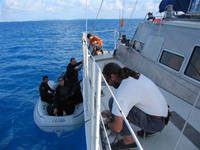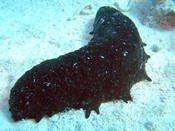May 12, 2005
Sea Cucumbers, Starfish and Sea Urchins.

Since the Oceana expedition arrived in Bermuda, the weather has been dreadful, with winds of 30 knots, rain and two meter waves. Yesterday we went out to see if we could go on our first dive, as the wind had decreased to 10 knots and the water did not see too murky.
“On our way to the reef area, while on the auxiliary raft, we stop to film a Portuguese Man-of-war (Physalia physalis). We had just reached our spot, when we found almost at surface level, at one meter deep a juvenile specimen of loggerhead turtle (Caretta carettta) two or three years old. Its carapace may have measured 30 to 50 centimeters long, similar to the size of turtles from the Azores area; with the Gulf Current in their favor, they could be there in 10 days” Ricardo tells us, at the end of three hours of intense work which he shared with the divers, Mar, Houss, Sole and Bibi. The latter was in charge of the auxiliary boat.

At the reef we found an abundance of grooved brian coral (Diploria labyrinthiformis), porous coral (Porites astreoides) Gorgonian Symbionts (Symbiodinium spp), and some gorgonians (Plexaura spp and Plexaurela spp). The bicolor parrotfish (Cetoscarus bicolor) were huge, measuring at least half meter. Our companions also saw many yellow boxfish and labridaes. “But the most spectacular aspect is that it was overflowing with Holothuria (Isostichopus badionotus) animals that belong to the equinoderm group and therefore, close relatives of starfish and sea urchins” All these species are organized in geometrical forms”. In order for us to understand the symmetry among equinoderms, my Zoology teacher gave us a very visual example. She said: “Imagine a starfish. If it closed its legs in the shape of the orange slices, it becomes like a sea urchin, and if you stretch it as if it was made of plasticine, you would have a Holothuria” Indi told us this later while he cooked dinner.
The Holothuria is also known as Sea Cucumber, for their elongated shape. Another distinctive characteristic are its tiny feet which allow it to move along the sea floor. The sea cucumbers sighted by our Oceana divers had three rows of feet (on both sides and in the middle), arranged in the shape of a mechanical caterpillar. Unfortunately, the Holothurias are also under exploitation as edible species. Those found in Asia and in the Galapagos, just to name two examples, are being severe extermination on the part of pirate fleets, because they are considered “delicatessen”. If there is any exploitation of holothurias in Bermudas, it must be under tight regulation.


The Mediterranean holothurias do no have spikes, as do their Bermuda relatives. They live in surface waters, at depths of four to twelve meters. Some of my expedition companions report having seen them on the beach, at a short distance from swimmers.

